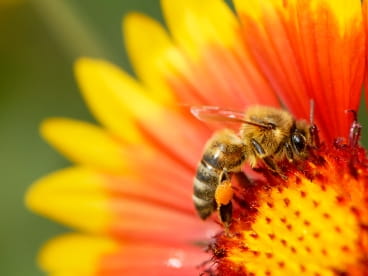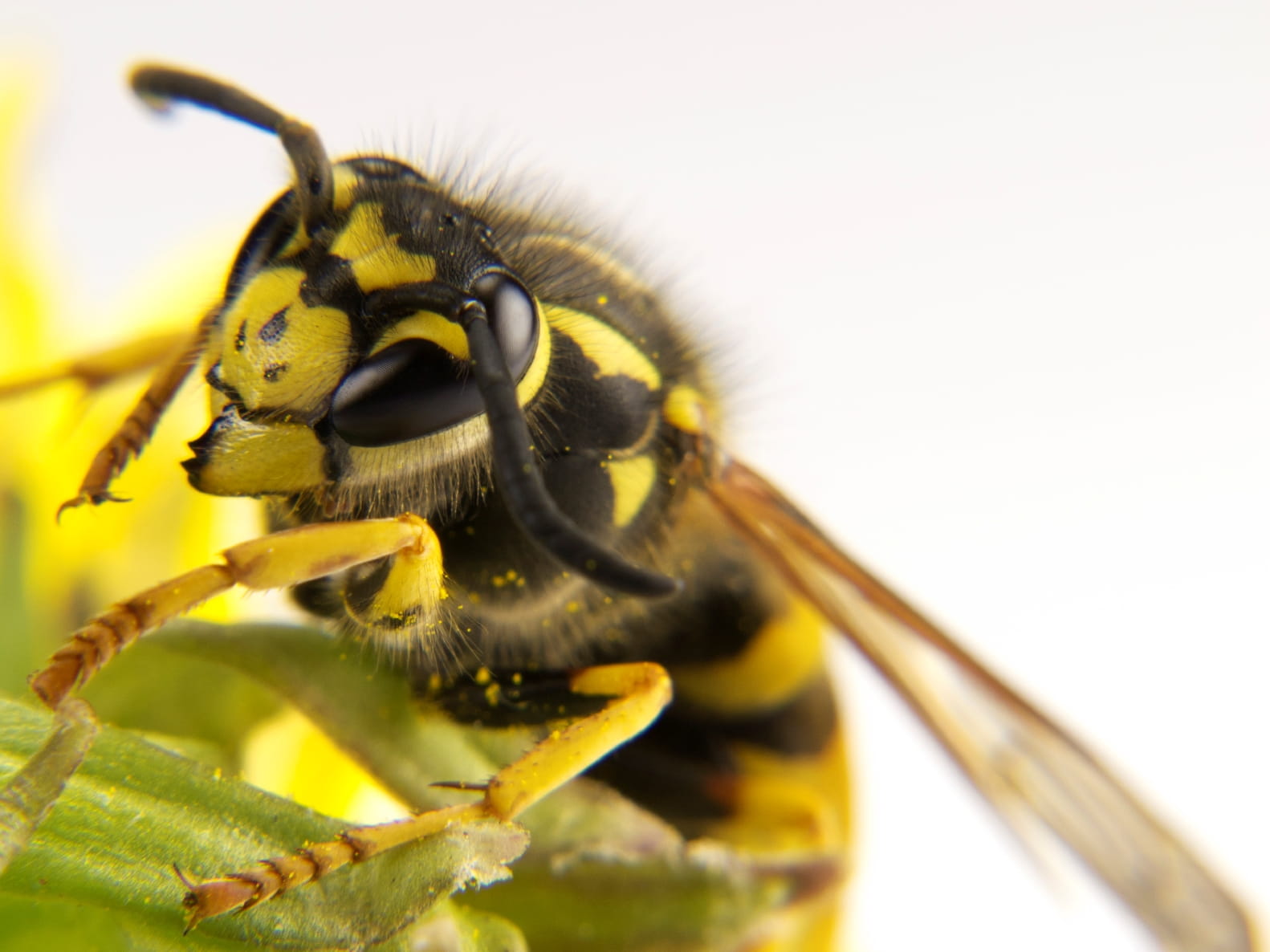Bee Stings: Is It an Allergic Reaction?

The Bottom Line
Stings from bees, wasps, hornets, and yellow jackets are common and painful. Pain, swelling, and itching at the site of the bite are common. An allergic reaction includes trouble breathing, chest tightness, and swelling on the body someplace other than the bite site. Allergic reactions to a bite or sting are medical emergencies. Call 911 right away.

The Full Story
Bees, wasps, hornets, yellow jackets: most people can't tell them apart. But they all sting - and there's no mistaking that sting! The pain is immediate and intense. The area becomes red, itchy, and swollen.
Lots of people call Poison Control after being stung. They worry that they're having an allergic reaction because the pain, itching, and swelling are so alarming. How can you tell the difference between a miserable sting and an actual allergic reaction?
Anaphylaxis is the name for severe allergic reactions that can cause a person to collapse and die. An anaphylactic reaction to a sting (or just about anything else) causes trouble breathing. This happens quickly, within minutes to an hour. The victim could have chest tightness and a feeling of tightness in the throat. The person could feel faint. Hives (red, itchy bumps on the skin) pop up away from the bite. This is a true medical emergency. Call 911 right away! If the person has a kit to treat allergic reactions, start using it immediately. (Follow directions to use the "Epi-Pen", a shot of epinephrine. Usually, you would open the package and push the auto-injector against the person's thigh.) Put the person on the floor, on his or her left side. Put any pets behind closed doors. Unlock the door so emergency personnel can get in. If you see a stinger in the wound, remove it as described below.
A person who has multiple stings might also need emergency care. In this case, it's not an allergic reaction. But, the quantity of venom injected all at once could cause nausea, dizziness, faintness, and even seizures.
All symptoms of an "ordinary" sting are at the sting site itself. Expected effects are pain, swelling, redness, and itching. All effects are at that specific spot. Even if the area is still red, swollen, itchy, and painful the next day – it's an expected reaction, not an allergic reaction. Treatment is in two parts:
- If there is a stinger in the skin, remove it gently. Scrape it out with something that's not sharp: a finger nail, the edge of a credit card, or the dull side of a knife. Do not use tweezers or fingers to grab the stinger and pull it out; that pushes more venom into the skin.
- Wash the area well with soap and water. Apply ice to help relieve itching, swelling, and pain. There's no one treatment that works all the time. You can apply a cortisone cream, an antihistamine cream, or a paste of baking soda and water. Treat severe itching with an antihistamine. Diphenhydramine (Benadryl®) and chlorpheniramine might help. Be sure to follow label instructions for dose and precautions; these drugs can cause sleepiness. Try an over-the-counter pain reliever for pain.
In all cases, try to avoid scratching. (That's easy to say…) Scratching the bite site could cause an infection. Covering the sting site might help.
Has the victim had a tetanus booster in the last five years? If not, or you don't know, call the doctor to see if a booster would be a good idea.
If your local reaction is very large - several inches across - give your doctor a call. Some people with this type of reaction go on to develop severe allergies or anaphylaxis.
You can call Poison Control at 1-800-222-1222 or use the webPOISONCONTROL® online tool at any time for expert guidance if you are stung.
Rose Ann Gould Soloway, RN, BSN, MSEd, DABAT emerita
Clinical Toxicologist
Poisoned?
Call 1-800-222-1222 or
Prevention Tips
- To prevent infection after a bee or wasp sting, treat pain and itching – but do not scratch!
- Call 911 right away if someone has trouble breathing after a sting.
- Call 911 if someone gets swelling or hives anywhere on the body besides the sting itself.
This Really Happened
Case 1: A 40-year-old woman ate a sandwich, not realizing there was a wasp on it. The wasp stung her tongue. Thirty minutes later she developed general body itching and used her EpiPen®. About thirty minutes after that, she developed a swollen tongue and hives all over her body and took cetirizine (an antihistamine). She called Poison Control and was immediately referred into the nearest emergency room. She was given additional epinephrine and was observed for a few hours. Poison Control followed up on her by phone at home the next day. She had not developed any further problems.
Case 2: An 8-year-old boy was stung by a bee on the inner thigh and complained of a lot of pain. His mom didn't note any stinger at the site. She called Poison Control and followed advice to clean the area well and apply a baking soda paste and ice over the area. Later she applied an antibiotic ointment. The child had a lot of pain for a few hours. His mom gave him acetaminophen for pain and diphenhydramine, an antihistamine. The following day when Poison Control checked back on him by phone, his mom said he still had a little soreness at the sting site but was outside playing.
For More Information
Mayo Clinic: [Internet] Rochester MN: Mayo Foundation for Medical Education and Research; c 1998-2012. Bee stings; 2010 Nov 23 [cited 2014 Jan 3] [about 7 screens].References
Poisoned?
Call 1-800-222-1222 or
Prevention Tips
- To prevent infection after a bee or wasp sting, treat pain and itching – but do not scratch!
- Call 911 right away if someone has trouble breathing after a sting.
- Call 911 if someone gets swelling or hives anywhere on the body besides the sting itself.
This Really Happened
Case 1: A 40-year-old woman ate a sandwich, not realizing there was a wasp on it. The wasp stung her tongue. Thirty minutes later she developed general body itching and used her EpiPen®. About thirty minutes after that, she developed a swollen tongue and hives all over her body and took cetirizine (an antihistamine). She called Poison Control and was immediately referred into the nearest emergency room. She was given additional epinephrine and was observed for a few hours. Poison Control followed up on her by phone at home the next day. She had not developed any further problems.
Case 2: An 8-year-old boy was stung by a bee on the inner thigh and complained of a lot of pain. His mom didn't note any stinger at the site. She called Poison Control and followed advice to clean the area well and apply a baking soda paste and ice over the area. Later she applied an antibiotic ointment. The child had a lot of pain for a few hours. His mom gave him acetaminophen for pain and diphenhydramine, an antihistamine. The following day when Poison Control checked back on him by phone, his mom said he still had a little soreness at the sting site but was outside playing.
